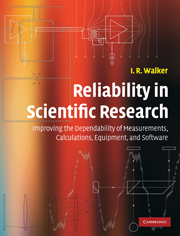 Reliability in Scientific Research
Reliability in Scientific Research Book contents
- Frontmatter
- Contents
- Preface
- List of abbreviations
- 1 Basic principles of reliability, human error, and other general issues
- 2 Mathematical calculations
- 3 Basic issues concerning hardware systems
- 4 Obtaining items from commercial sources
- 5 General points regarding the design and construction of apparatus
- 6 Vacuum-system leaks and related problems
- 7 Vacuum pumps and gauges, and other vacuum-system concerns
- 8 Mechanical devices and systems
- 9 Cryogenic systems
- 10 Visible and near-visible optics
- 11 Electronic systems
- 12 Interconnecting, wiring, and cabling for electronics
- 13 Computer hardware and software, and stored information
- 14 Experimental method
- Index
- References
5 - General points regarding the design and construction of apparatus
Published online by Cambridge University Press: 05 June 2012
- Frontmatter
- Contents
- Preface
- List of abbreviations
- 1 Basic principles of reliability, human error, and other general issues
- 2 Mathematical calculations
- 3 Basic issues concerning hardware systems
- 4 Obtaining items from commercial sources
- 5 General points regarding the design and construction of apparatus
- 6 Vacuum-system leaks and related problems
- 7 Vacuum pumps and gauges, and other vacuum-system concerns
- 8 Mechanical devices and systems
- 9 Cryogenic systems
- 10 Visible and near-visible optics
- 11 Electronic systems
- 12 Interconnecting, wiring, and cabling for electronics
- 13 Computer hardware and software, and stored information
- 14 Experimental method
- Index
- References
Summary
Introduction
The design and construction of scientific apparatus is often accompanied by serious pitfalls. These can be a cause of much wasted time, and a source of frustration to those who are not familiar with the problems. This chapter examines a few of most common difficulties, and some useful general strategies for easing the development of reliable apparatus. Detailed design and construction considerations are discussed elsewhere in the book, and in the references at the end of the chapter.
Commercial vs. self-made items
One should generally not make equipment and parts that can be obtained commercially. An important reason for this is that it very often takes much longer to design and construct such items in a research laboratory than is originally envisaged (see Section 5.3). Most of the things that are done in a laboratory are not new. Hence, much time and effort can be saved by making full use of the multitude of products that are available on the market, and easily located on the Web.
Many commercial devices of a given type may be made by a company, and several generations may be designed and manufactured over the years. For this reason, the people who design these devices (often professional engineers) frequently have considerable experience in dealing with their potential problems. Furthermore, since large development costs can be spread out over many units, the reliability, ease-of-use, and performance of these can be much higher, given the cost, than those of equivalent devices designed and built in-house.
- Type
- Chapter
- Information
- Reliability in Scientific ResearchImproving the Dependability of Measurements, Calculations, Equipment, and Software, pp. 127 - 137Publisher: Cambridge University PressPrint publication year: 2011


